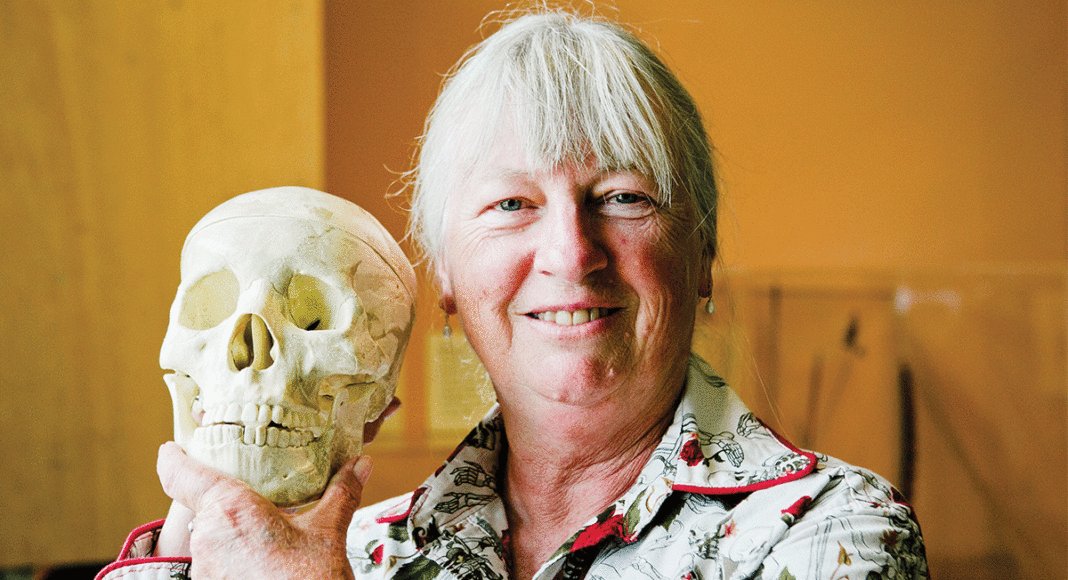When faced with the thought of their own deaths, people sometimes wonder: What will become of my remains? Who will discover the body?
It may seem impossible to know such answers, but Alison Galloway has the grotesque visitation schedule down to a science.
“Typically, the flies are the first to arrive,” Galloway says.
Galloway is a professor of anthropology at UCSC, where she specializes in the study of human skeletons. She often works with law enforcement agencies as a forensic anthropologist, identifying and analyzing human remains.
Galloway visits the Rio Theatre on June 6 to share stories from her many years as a world-renowned expert and to talk about what happens when we leave our bodies behind. “I want to remind people that we are part of the cycle,” says Galloway, who served as UCSC executive vice chancellor from 2010 to 2016, “and that our bodies behave the same way as any other carcass.”
Galloway’s talk—“Life of the Dead: The Natural History of Human Decomposition,” organized by the Santa Cruz Museum of Natural History—will explore the processes that unfold within a freshly dead human carcass, and it won’t be for the faint of heart. The old “Hearse Song”—about creepy crawlers going to town on the body—isn’t far off.
Blow flies, Galloway says, are among the first to find the carcass, and they thrive on human flesh. Females must lay their eggs in the nutrient-rich tissues of dead creatures. They use their antennae to pick up on the volatile compounds released from desiccating bodies.
Next, rigor mortis sets in as calcium accumulates in the muscles and blood pools in the lower body parts. Oxygen deprivation kills the cells that compose our tissues, and they eventually spill their contents, marking the onset of putrefaction.
The body then bloats, Galloway says, swelling up and eventually beginning to dry—either quickly or slowly, depending on the environment. Other organisms—from flies and fungus to bacteria and beetles—visit the body at reliably specific stages. These phases signal clues as to the time of death.
Beetles, Galloway says, are among the last creatures to show up, as they prefer consuming the “drier, leathery flesh.”
“She’s not only an expert. She’s also a very good storyteller,” says Heather Moffat McCoy, executive director of the Museum of Natural History, which hosts a speaker series to welcome scientists like Galloway. “I think this topic in itself is fascinating, but I also think she’ll share it in a wonderful way.”
McCoy says the museum’s mission is to connect people to the natural world. That’s something they strive for in various programs, from teaching kids how animals move in nature to more “adult programming” like Galloway’s upcoming talk.
Galloway began her career in archaeology. As she excavated artifacts and tools from dig sites in the American Southwest and Ethiopia, she felt most fascinated by bones. Soon she met a forensic anthropologist, and her path was forged. Once she completes her sabbatical this year, Galloway plans to return to teaching courses in forensic anthropology and skeletal biology at UCSC.
Galloway realizes the career she’s chosen often gets dramatized on crime-centric television shows, creating misconceptions about what it is forensic anthropologists actually do.
“In a lot of crime shows, the anthropologist is heavily involved in the investigation, running around interviewing people,” says Galloway. “We don’t do that. We don’t carry a gun or go looking for serial killers in the middle of the night. It’s just not what we do.”
Instead, Galloway interviews the skeleton—the body its own miniature ecosystem. But to get there, she has to get past the flesh. “To put it politely, we have to extract the skeleton,” says Galloway.
“It’s not a pleasant process,” she adds.
First, she must “deflesh” the skeleton, cutting away gobs of soft tissue. Then, she sets the bones in an incubator, which loosens up any remaining flesh that can be washed away. This process, she adds, is often left out of crime drama shows.
One case, she recalls, ended with a full confession from the killer.
“I had drawn my conclusions,” says Galloway, “when just before we went to trial, they asked, ‘Would you like to hear his confession?’ I said, ‘Yeah, I would!’”
In it, the killer had detailed every bit of damage, explaining how he’d cut through the victim’s chest and twisted her neck. The details of the confession matched Galloway’s conclusions exactly—“I could literally go down and link an injury to everything he said he’d done,” she says.
Alison Galloway’s June 6 presentation at the Rio Theatre is part of the Santa Cruz Museum of Natural History’s twice-annual speaker series, where researchers from different scientific disciplines share their work in engaging and accessible ways. Tickets are $15-$30.













